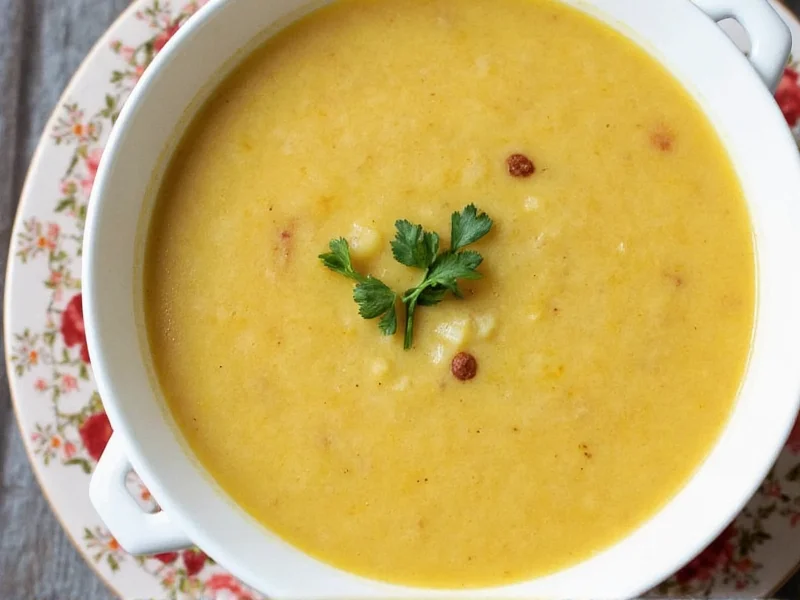Choosing the right potato variety can make or break your soup. The starch content and texture of different potatoes dramatically affect how they behave when simmered in liquid, influencing everything from thickness to mouthfeel. Understanding these differences helps you select the perfect potato for your specific soup recipe.
Why Potato Selection Matters for Soup
Potatoes contain varying levels of starch and moisture, which determines how they react during cooking. High-starch potatoes like Russets break down more readily, releasing starch that thickens the broth naturally. Low-starch, waxy potatoes maintain their shape better, making them ideal for chunky soups where distinct potato pieces are desired. The wrong potato choice can lead to soups that are either too thin, overly thick, or have unpleasantly disintegrated or hard potato chunks.
Top Potato Varieties for Soup Compared
| Potato Variety | Starch Level | Best Soup Types | Key Characteristics |
|---|---|---|---|
| Russet (Idaho) | High | Creamy soups, chowders, pureed soups | Breaks down easily, creates natural thickness, fluffy texture when cooked |
| Yukon Gold | Medium | Most soup applications, versatile choice | Balanced texture, buttery flavor, maintains some shape while thickening broth |
| Red Potatoes | Low (waxy) | Chunky vegetable soups, hearty stews | Holds shape well, firm texture, slightly sweet flavor |
| Fingerling | Low-Medium | Specialty soups, rustic presentations | Maintains shape, unique appearance, nutty flavor |
| White Potatoes | Medium | General soup applications | Similar to Yukon Gold but less buttery, reliable performance |
Detailed Breakdown of Best Potatoes for Soup
Russet Potatoes: The Thickening Powerhouse
Russet potatoes contain the highest starch content among common varieties, making them exceptional for creamy soups and chowders. As they cook, Russets break down and release starch that naturally thickens your soup without needing additional flour or cornstarch. This property makes them ideal for New England clam chowder, potato leek soup, and other pureed soup recipes where a smooth, velvety texture is desired. When using Russets, add them at the beginning of cooking to allow sufficient time for them to break down properly.
Yukon Gold Potatoes: The Versatile All-Rounder
Yukon Gold potatoes represent the perfect middle ground for most soup applications. With medium starch content, they offer buttery flavor and a texture that maintains some structure while still contributing to a creamy consistency. These potatoes work beautifully in almost any soup recipe, from hearty vegetable soups to creamy potato soup. Their natural buttery flavor enhances the overall taste profile without requiring excessive added fats. For best results with Yukon Golds in soup, cut them to uniform sizes and add them midway through cooking to prevent over-softening.
Red Potatoes: The Shape Holders
When preparing chunky vegetable soups or beef stews where distinct potato pieces are essential, waxy red potatoes prove invaluable. Their low starch content allows them to maintain their shape during extended cooking times. Red potatoes add visual appeal with their colorful skins and provide a firm, satisfying bite. These potatoes excel in minestrone, Irish stew, and other recipes where you want recognizable potato chunks. To maximize their performance in soup, add red potatoes later in the cooking process since they require less time to become tender.
Potatoes to Avoid for Soup
While most potatoes can technically be used in soup, some varieties create suboptimal results. New potatoes, while delicious roasted or boiled, often become too soft in soup. Sweet potatoes behave differently due to their sugar content and are better suited for specialty soups rather than traditional potato-based recipes. Avoid pre-cut or instant potatoes, as they frequently contain additives that affect texture and flavor. Frozen diced potatoes typically have inconsistent texture and may become mushy when cooked in soup.
Pro Tips for Perfect Potato Soup Every Time
Regardless of which potato variety you choose, certain techniques ensure optimal results. Always peel potatoes for creamy soups but consider leaving skins on for rustic chunky soups (just scrub them thoroughly). Cut potatoes to uniform sizes for even cooking—aim for 1/2 to 3/4 inch cubes depending on your soup type. Never add cold potatoes directly to boiling soup; let them come closer to room temperature first to prevent uneven cooking. For cream-based soups, add potatoes to cold liquid before heating to promote even starch release. If your soup becomes too thick, gradually add broth or milk rather than water to maintain flavor. For chunky soups, add potatoes during the last 15-20 minutes of cooking to preserve their shape.
Matching Potatoes to Specific Soup Types
Different soup styles benefit from specific potato choices. For pureed soups like vichyssoise or classic potato soup, Russets provide the ideal texture. Yukon Golds shine in French onion soup with potato toppings and most vegetable medleys. When making seafood chowder, combine Russets for thickness with a few waxy potatoes for texture variation. For German potato soup or other hearty European styles, white potatoes offer traditional flavor and reliable performance. In Latin American soups like caldo de papas, yellow potatoes create the authentic texture and taste. Understanding these regional and stylistic preferences helps you create more authentic and satisfying results.
Storage and Selection Tips
Choose firm potatoes without green spots, sprouts, or soft areas. Store potatoes in a cool, dark place with good ventilation—never in the refrigerator, as cold temperatures convert starch to sugar, affecting flavor and cooking properties. Keep them away from onions, which release gases that accelerate sprouting. For soup preparation, use potatoes within 2-3 weeks of purchase for optimal texture and flavor. If you need to prepare potatoes ahead of time, submerge cut pieces in cold water with a squeeze of lemon juice to prevent browning until ready to use.











 浙公网安备
33010002000092号
浙公网安备
33010002000092号 浙B2-20120091-4
浙B2-20120091-4